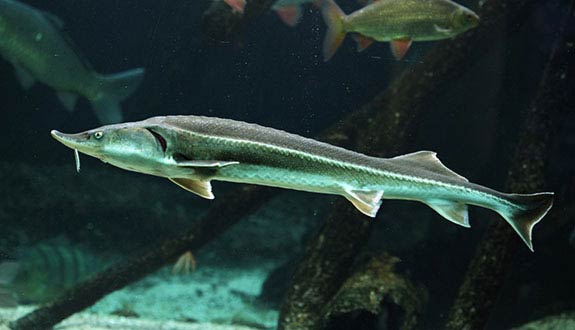How to choose the right sterlet?
The sterlet is one of the large fish. The size of an adult reaches 60 cm. A distinctive feature of this fish is a sharp head, on the front part of which two antennae are clearly visible. Sterlet has no scales, but there are plates resembling it. This type of fish is sold in frozen or chilled versions.
Sterlet can be sold:
- whole and uncut;
- gutted;
- frozen;
- in the form of fillets, packed in packages.
How to choose a sterlet
It is necessary to choose a sterlet in accordance not only with the general rules for buying fish, but also evaluate it according to some individual characteristics. If there is even the slightest doubt, then you should refuse to purchase it. Spoiled fish will not only taste bad, but also hazardous to health.
What sterlet can you buy:
- the surface of the chilled sterlet should always be wet, but not sticky or too slippery;
- any defects on the surface of the sterlet are not permissible (in places of damage, bacteria instantly form, which accelerate the process of rotting fish);
- the eyes of the sterlet should be clean and “look” evenly (if the “gaze” of the fish is directed upward, then its shelf life is too long);
- when pressing on the skin of the sterlet with a finger, there should be no dents (this method of assessment is applicable only to chilled fish, such an experiment will not work for a frozen product);
- the gills of fresh sterlet are always bright and have a characteristic red tint (the gills must be clean);
- when cutting, the meat of fresh sterlet is always difficult to separate from the bones;
- frozen sterlet should not be distinguished by too much ice or snow (if there is a lot of snow, and there is a yellow or pinkish tint on its surface, then the fish was frozen more than once);
- chilled or frozen sterlet must always be clean (frozen particles of debris, contamination in the gills or in other areas of the fish are a sign of violation of the rules for catching, transporting and storing it).
If the sterlet is purchased frozen, then it must be thawed naturally or in cold water. After thawing, the fish should retain its shape and traditional fishy smell.
What sterlet should not be bought:
- if the surface of the chilled fish is too dry or mucus is clearly visible, then you must refuse to buy it (the fish was stored improperly or began to deteriorate);
- if the characteristic fishy aroma contains extraneous odors, then you cannot buy sterlet (the smell may be rotten or resemble mold);
- yellow bloom on fish is always a sign of spoilage (bloom can be in the form of spots or streaks);
- you should not buy a sterlet if there are bruises, damage or stains of unknown origin on its surface);
- gray gills can only be found in sterlet, which has been stored incorrectly for a long time (any deviations from the red hue in this case should be a reason for refusing to buy fish);
- if the meat separates from the bones too well when cutting the sterlet, then the fish is not fresh (if such a nuance is combined with a sour smell and mucus on the skin, then in no case should such a sterlet be eaten);
- if, when pressing on the skin of the sterlet with a finger, a dent remains, then the fish is definitely stale (the sterlet can start to deteriorate, has been repeatedly frozen or thawed or was stored incorrectly);
- chilled fish can be sold on store shelves for a certain period of time (as a rule, no longer than 14 days), therefore, if there are suspicions, it is better to ask the seller for a certificate stating the date of the sterlet catch and the timing of its release on sale).
Instead of scales, sterlet has a kind of bone plates that can be indicators of the freshness of the fish. If they fit snugly to the body, then the sterlet is fresh. When the plates are peeled off, it will not be possible to name a quality fish.










